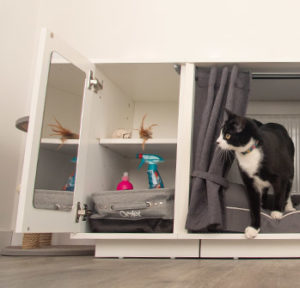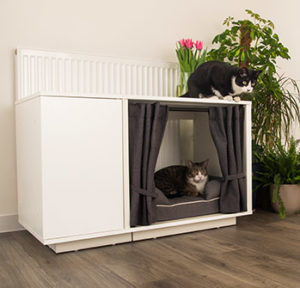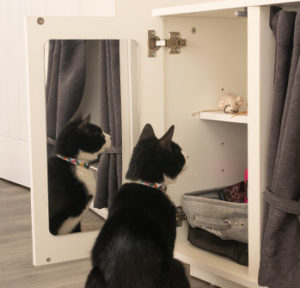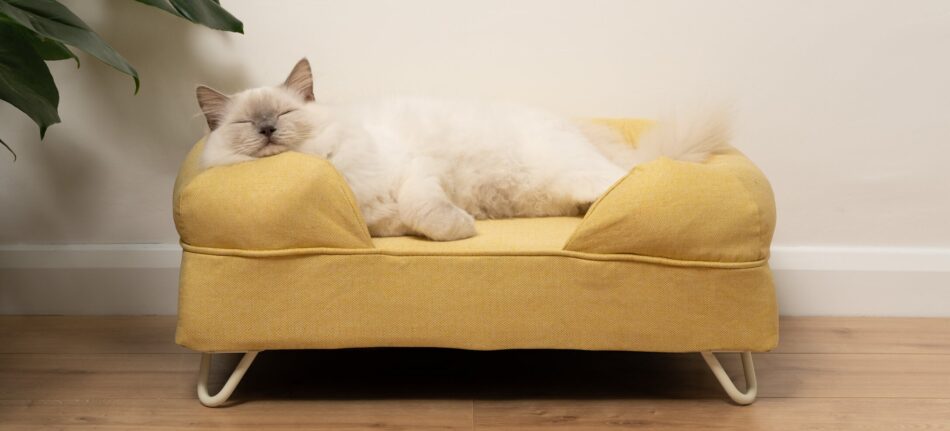
So you’re thinking about adding a cat or kitten to your family? Congratulations! But before you leap into feline parenthood, there are several crucial factors to consider to ensure you and your future furball enjoy a harmonious life together. The most important factor being where are you going to get your new furry friend. Rescuing a cat isn’t just an act of kindness, it’s a commitment that can span a decade or more. Luckily for you, we’ve compiled everything you need to know and consider before rescuing a cat.
Should I buy or rescue a cat?
Before going ahead with buying a kitten from a breeder, it’s important to remember there are lots of cats in rescue centres across the country, waiting for their forever homes. At Omlet, we strongly encourage visiting your local cat rescue before making a decision as there are a number of cats of all ages and breeds in centres. Here are some things to consider when deciding whether you should buy or rescue a cat:
Buying a cat:
- Breed preference: When you get your new furry friend from a breeder, you do have the ability to choose what specific cat breed you want. If, for example, you’re an allergy sufferer and need a hairless or hypoallergenic cat, then choosing this route might be best.
- Kittens available: While many rescue centres have kittens for adoption, the timing on when you want one and when they are available may not always match up. So if a kitten is a must for you, buying from a breeder may be best.
- Predictable temperament: No one can ever know for certain the true temperament of any animal, but when you buy a kitten or cat from a breeder you do get more information on their behaviour type as they know the parents and how they act.
Rescuing a cat:
- Saving a life: Adopting a cat or kitten from a shelter or rescue organization gives a homeless cat a chance at a loving home, potentially saving their life. But ask any parent of a rescue cat and they will say it was their furry friend that gave them the new appreciation for life.
- Diverse options: When you visit a rescue or shelter, one of the first things you’ll notice is the wide range of cat breeds, ages, and personalities that are available to be a part of your family. This variety allows cat lovers to truly discover which cat best suits their preferences.
- Lower cost: In general, adoption fees to get a rescue cat are lower than if you were to buy from a breeder. And, most rescue organizations provide essential vaccinations and spaying/neutering services, which saves even more in additional costs to consider.
Is my home, garden, and neighbourhood safe for a cat?
Think about where your home is located. Do you live by a busy street? This is important to consider as some rescue cat centres will actually not allow adoption if you live near a busy road – and for good reason. Some cats are skittish and can often put themselves in danger or at risk of injury when near a busy street. So to help avoid any unwanted tragedies, shelters and rescues avoid adopting out to these locations altogether.
Next, you need to consider whether your current home is really suitable and safe for a cat to be going outdoors. Is your garden space big enough, fenced in, and far enough away from neighbouring pets? If you didn’t answer ‘yes’ to all of these – fear not. You can still provide an alternative, secure outdoor space for your cat to play and exercise, such as an Outdoor Cat Run.
And if you live in an apartment and want to rescue a cat to be both an indoor and outdoor cat, you, too, can make it happen. With the Omlet Cat Balcony Enclosure you will give your cat the freedom to get some fresh air and playtime outside without fear of escape or injury.
Finally, it’s time to assess the surroundings within your home. Do you have other animals who could respond negatively to a new furry resident? When considering adopting a cat from a rescue or shelter, it’s important to first conduct a “meet and greet” with the other pets and children in your household. This allows everyone to get a firsthand experience of each other and see if there are any personality differences before welcoming a new member into the family.
Can I offer a secure space for the cat to feel comfortable?
For rescue cats, having their own space to hide when they get scared or anxious is incredibly important. Does your home have plenty of hiding spaces for your new cat to disappear to when it all gets too much?
The Maya Nook Indoor Cat House is the ideal den for nervous cats to be tucked away in or just to find their personal peace and quiet. The exclusively designed curtains provide a completely secluded space which allows your cat the ability to feel safe while still being able to check on their surroundings.
Can I provide a rescue cat with the support they need?
One of the best parts of rescuing a cat is seeing the transformation in their personality as they realize they are now part of a loving home. But in order for your new, rescued friend to feel at ease, they’ll need to receive lots of patience and support from you. Becoming settled into a new environment and new life takes time and will require you to be flexible and understand that it doesn’t happen overnight.
Consider first your job – do you want to rescue a cat but work full-time? If so, try and plan some days off before you bring your rescue home to allow much needed time to help your new furry friend get settled in. Spend this time helping them get used to their new surroundings and know where their litter box and cat food bowls are. And if your household has children, you’ll need to prepare them as well to be gentle and quiet with the new cat.
Most rescue cats are discharged from rescue homes with a full bill of health, but on the odd occasion they’re not, some cats may need a few more vet visits, or even repeat medication. If you rescue such a cat, be prepared to accept the cost and commitment required to provide the healthcare they need.
What will I need to settle a rescue cat into my home as smoothly as possible?
While love and patience are the two most important ingredients in making your new rescue adjust to life in your home, there are some essential cat products that will help make this transition easier on everyone.
- Bathroom time: Litter tray, cat litter, scoop
- Sleep time: Cat bed(s)
- Eating time: Cat food bowls – speak to the rescue centre about what food the cat has responded to best, e.g. wet or dry
- Reward time: Cat treats
- Playtime: Cat toys
- Travel time: Cat carrier
- Zen time: Calming products – e.g. Feliway
- Safe outdoor time: Outdoor cat enclosure
Omlet and your rescue cat
At Omlet, we are a pioneering company in cat care. We craft our products to simplify cat rescue efforts and make pet parenting easier. By understanding feline behaviour and the challenges and rewards associated with rescuing a cat, we are able to design innovative solutions that make the process effortless. From our supportive and comfy cat beds to our furniture-style cat houses to our safe and secure outdoor Catio enclosure, we think about your cat first so all you need to do is be the best rescue cat parent you can be.
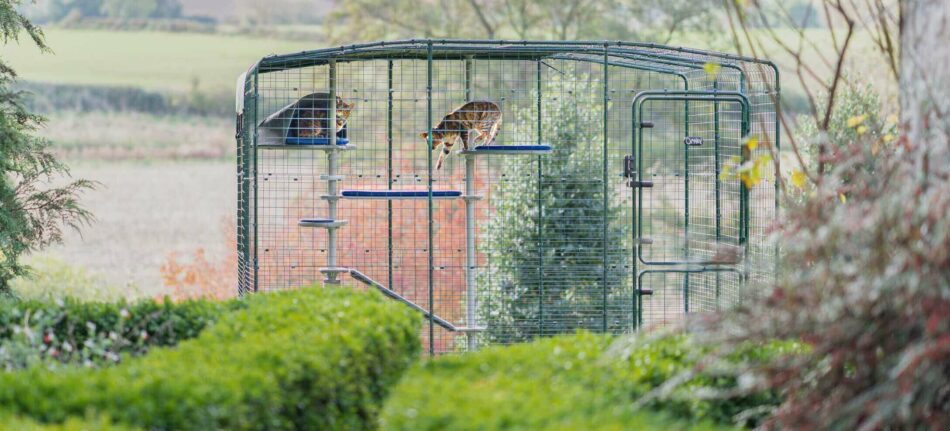
This entry was posted in Cats on May 28th, 2019 by chloewelch
Treat your cat this weekend and save 15% on ALL Cat products until midnight on Monday.

That’s right – everything CAT is now 15% off, including the NEW Maya Nook Luxury Indoor Cat House, available with stylish curtains and a handy wardrobe, giving your cat a cosy, secure space they can call their own, and blending seamlessly into your home.
Our Outdoor Cat Runs are also included in the sale. You could even upgrade your existing enclosure with our range of extensions, covers, porch and partitions – all with 15% off!
Don’t miss out on this purrfect opportunity to treat your feline friend – they deserve it!
Terms and conditions
This 15% off promotion is only valid from 24/05/19 – midnight ACT on 27/05/19. 15% off requires no promo code. This offer is available on all cat products listed in our cat category only. Subject to availability. Omlet ltd. reserves the right to withdraw the offer at any point. Offer cannot be used on existing discounts or in conjunction with any other offer.
This entry was posted in Cats on May 24th, 2019 by chloewelch
Many cats in rescue centres looking for a new home have had a very tough time of it. Whether mistreated, abandoned, stray, or injured, the kitties who find themselves in the care of a rescue organisation can, quite understandably be wary of humans. But this isn’t a reason to give up on them.
When I adopted my cat he was depressed and overweight due to the large amount of time he had spent hidden away in his kennel, showing no interest in playtime or human interaction. He had been with the rescue organisation for 4 months and not one person had shown him any interest. Stress had caused his fur to come out in great tufts, but as I stroked him he let out a little purr. I adopted him then and there.
On bringing Smudge home, I opened the door to his cat carrier but he refused to step out for a good few hours, and when he did he scarpered under the kitchen table, hidden as best he could.
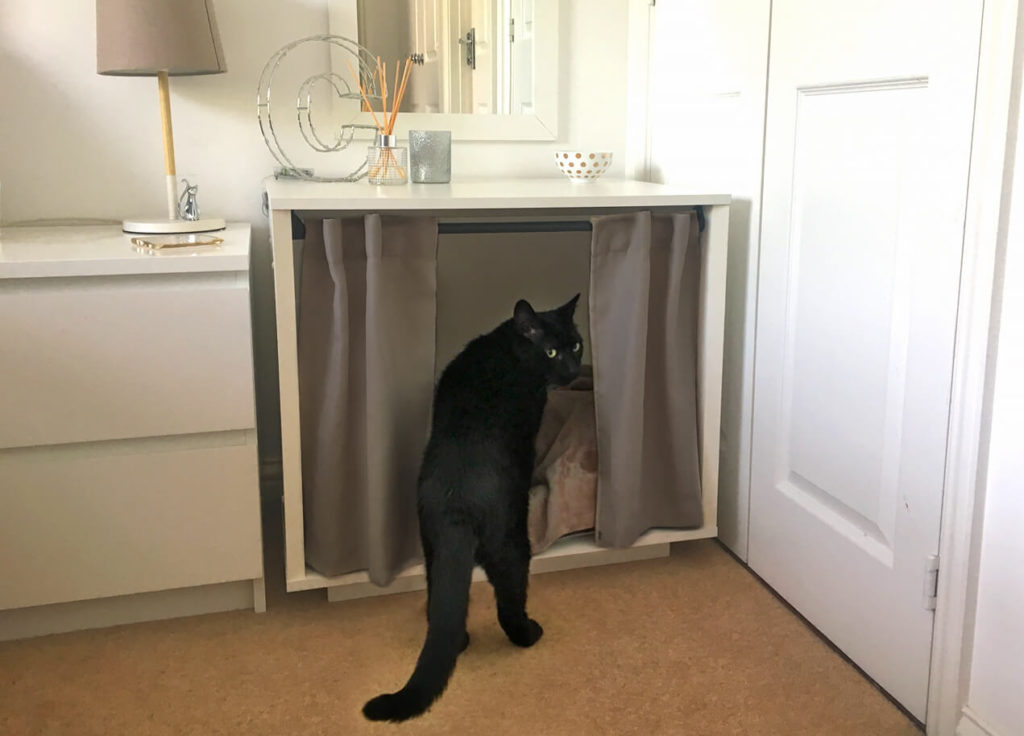
In his first few weeks with us he spent a lot of time hidden under beds, behind the sofa, in between boxes or attempting to blend in to a pile of clothes or under a blanket. It took a long time for Smudge to be brave enough to spend time on the sofa and beds, and even then he wouldn’t be up there for long until a slight movement or noise would frighten him and he would vanish.
It became very obvious he was going to take a bit more time to settle in and to feel less afraid, so I was going to need to think outside of the box – or more so inside. As I noticed he felt most secure in an enclosed space where nothing could reach him and he was protected from harm, I started to think about the best kind of bed to suit his timid personality.
The Maya Nook is a cosy indoor Cat House with curtains. Yes, you heard that right, it’s got curtains. But before you start rolling your eyes at another example of anthropomorphism, let me explain. The curtains not only make the Nook look really nice, they are also fully functional and transform the Nook into an enclosed little ‘room’ where cats can rest and sleep in a peaceful, secure space they can call their own. Placing their bed in a den-like Nook gives them a sense of distance and security from a busy home life, while the addition of the curtains completely closes off their space so they cannot see outside, and likewise they cannot be seen.
When I introduced Smudge to the Maya Nook, it took a short while for him to get used to it. I allowed him to spend some time alone with it, giving him the opportunity to approach it at his own will, instead of picking him up and forcing him inside, which I thought could create a negative association. He spent some time sniffing around, going in and out for short periods of time with the curtains open. When he had settled inside for the first time, I closed the curtains for 30 seconds or so and opened them again. I repeated this a couple of times so he could get used to both scenarios.
When he would spend time hidden behind the sofa or under a bed, he seemed to mostly be awake and on guard, unable to relax, whereas now that he is sleeping in his Maya Nook, I feel as though he is getting much better quality rest and actually being able to switch off from what is happening on the other side of the curtains.
The combination of a quiet space and better sleep time has had a multitude of benefits to Smudge’s progress in our home. He is visibly more relaxed and spends more time out of his bed and in the open space with the family, compared to when he spent all of his time hidden and stressed. He is beginning to open up to the possibilities of play time, visitors are still feared but he is becoming braver with showing his face, and always has the comfort of being able to run to his Nook whenever it gets a bit too much for him.
I am sure this will also be hugely beneficial for events such as Fireworks Night and New Years Eve, when the bangs and pops of fireworks can be relentlessly frightening and heard for weeks on end. The Nook will help to reduce the sound, while the curtains will block out any flashing lights coming through the window.
The Maya Nook is designed to fit in the home like a piece of furniture, so we are able to use the space on top for whatever we please. It is a great spot to feed my cat and keep his water bowl so it is always close by and in his “safe zone.” The Maya Nook is also available with a handy fitted wardrobe which provides extra storage for cat food, treats and toys.
Adopting a rescue cat is really rewarding and I’m so glad that I didn’t let Smudge’s initial shyness put me off. If you have adopted or are thinking of adopting a rescue cat who continues to be very nervous and stressed in your home, I would highly recommend providing them with an indoor cat house like the Maya Nook so they can claim a secure space for themselves – it could transform your cat’s personality.

This entry was posted in Cats on May 20th, 2019 by chloewelch

How do chickens lay eggs? Chicken keepers and egg eaters alike often ask this question. This fascinating process is complex, but occurs daily within laying hens. Take an in-depth look at the egg-laying process from start to finish – it’ll make you give your laying hens a round of applause.
Egg-laying frequency
Eggs are amazing feats of nature. Not only are they considered a superfood due to their nutritional value, but laying hens can produce over 300 eggs per year. A small flock of laying hens can easily provide your family with fresh eggs.
Ovulation takes place every 24-36 hours for most laying breeds of chickens. This results in an egg being laid roughly every day and a half. Some laying breeds can lay an egg every day or more. The world record number of chicken eggs laid in a year is 371 eggs in 364 days, set by a White Leghorn hen in 1979.
The process of laying an egg
Chickens ovulate like other animals, but instead of eggs the size of small cells being released, hens lay the nutritious, tangible orbs that we enjoy for breakfast. The process of laying an egg takes around 24 hours, and hens as young as 18 weeks old can begin laying. We’ll break down each step of the egg-producing process.
Step 1: it starts with light
Egg laying actually starts with your chickens’ eyes. Sunlight enters through a hen’s eye and activates a photosensitive receptor called the pineal gland – located behind the eye. Once the pineal gland is stimulated, it triggers a string of events that releases an egg, or oocyte, from the hen’s ovary. This light sensitivity is one of the reasons chickens lay fewer eggs in the winter.
Step 2: formation of the yolk
Hens are born with two ovaries, but the right ovary becomes dormant after a female chick hatches. The left ovary is the one that will produce eggs throughout a hen’s lifetime and contains thousands of ovum, which will become future eggs.
If you were to look inside a chicken, these undeveloped ova can be seen at the start of the spine. When the chicken is old enough to start laying, some of these ova begin to mature into what will later become the yolk. At this stage, the ova are separated and contained within their own follicles, but when one is ready to move on it releases its follicle and moves out of the ovary and down the reproductive tract, the oviduct.
This process, called ovulation, occurs approximately every 25 hours, and normally starts again about an hour after the previous egg has been laid.
Step 3: egg white surrounds the yolk
Up until this point in ovulation, all chicken eggs are unfertilized. Hens can lay eggs with or without the presence of a rooster, but they can be fertilized if you keep a cockerel in your flock. Fertilized eggs are edible, as long as you collect the eggs daily.
Via the infundibulum, the yolk enters the oviduct, and it is here that the egg is fertilized if a rooster has courted your hen. You might have noticed that egg yolks have a small, white spot on them. This is the blastodisc, the single female cell that together with the sperm will develop into an embryo through cell division.
The journey of the egg is, however, the same regardless of whether it’s been fertilized or not. The yolk travels through the magnum and isthmus parts of the oviduct, and this is where the egg white (also called the albumen) is created. It works as a thin membrane around the yolk that holds everything together. The chalazae, two spiral bands of tissue, make sure that the yolk is evenly positioned within the albumen, and the whole thing starts looking like an egg – without its hard covering.
Step 4: the shell is formed around the egg
The egg receives its shell in the uterus, through the shell gland. It takes roughly 20 hours to produce the shell, and is the most time-consuming part of the process. Before the egg moves on for the last time, the outermost layer, known as the bloom or cuticle, is formed to create an antimicrobial layer around the shell. When the egg is ready, the shell gland pushes the egg out of the oviduct and into the cloaca or vent, the part where the reproductive and excretory tracts meet. Hens excrete all eliminations through the vent, but the hen’s uterine lining actually wraps around the egg until it is completely free from the hen’s body – keeping it nice and clean.
Egg laying the Omlet way
And there you have it – the amazing journey an egg makes before being laid by a hen. Our chicken coops offer your hens a safe and comfortable place to deposit the fruits of their labour. And to store those labours of love, try our Egg Skelter, which will proudly display your hens’ amazing, natural works of edible art.
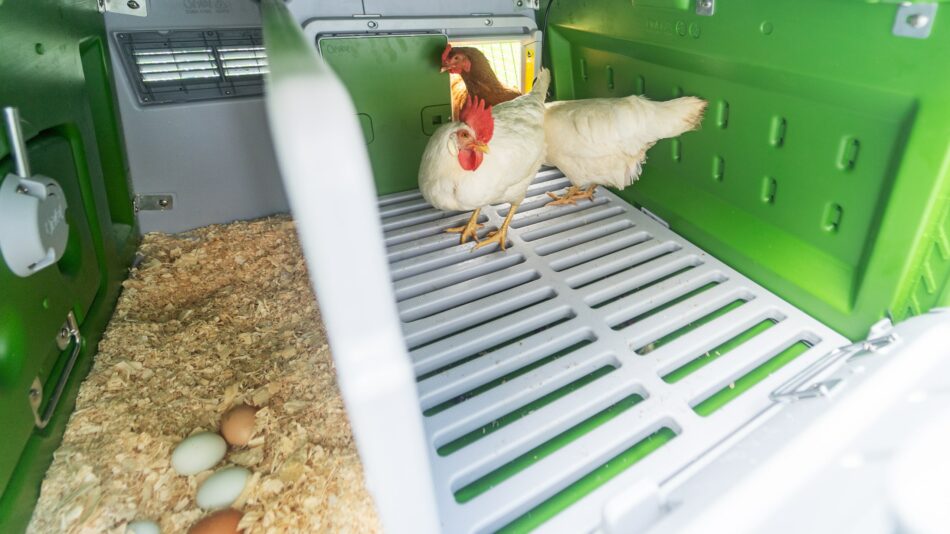
This entry was posted in Chickens on May 20th, 2019 by linnearask
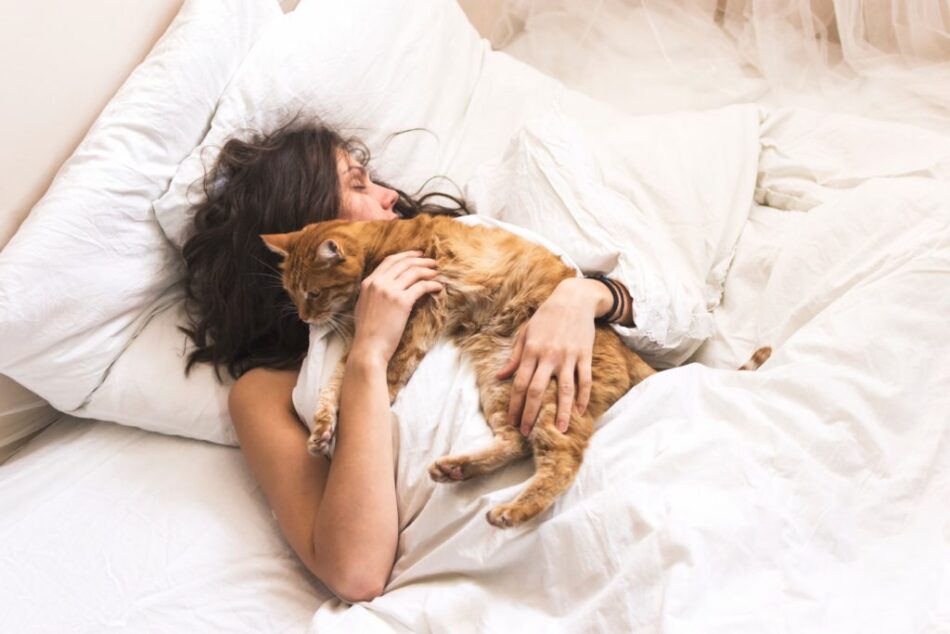
More than 80% of cat owners are having their sleep disturbed by their feline friends, reveals latest Omlet survey.
Following a discussion amongst the Omlet cat owners about the close sleeping arrangements with our pets, and the resulting impact on our daytime energy levels, we began wondering whether it is actually normal, or wise, to be allowing our cats to sleep in our beds?
Are we just soft when it comes to letting our cats get cosy at night, or are we a nation of pet slaves who value our cats happiness more than our own sleep?
To find out we decided to conduct a survey to shed light on the sleeping patterns of cats and how their nocturnal habits affect their owners. Over 900 cat owners responded and more than half (56%) said they let their cat sleep on the bed with them at night, with 40% allowing them to do so on the first day! In fact by the end of the first month of cat ownership the number has increased to 71% of owners allowing their cats into their bed at night.
A massive 84% of cat owners who allow their cat to sleep in their bedroom admitted to having their sleep disturbed by their cat – and as a result 1 in 5 cat owners sometimes resent their cat following a bad night’s sleep. Could this cosy sleeping arrangement actually be negatively impacting the nations’ relationship with their cats?
We invited these cat owners to share how exactly their cat disturbs their sleep. Many agreed that the main disturbance is due to their cats lying too close to them, purring, snoring or cleaning themselves. However, here are our top 10 favourite, more unusual, ways that cats are disturbing their owners sleep…
- Chasing mice around the bedroom
- Patting my face
- Trying to eat my toes
- Zoomies at 3am
- Dribbling on me
- Hairballs
- Trying to wake me up for breakfast, or asking for a snack
- Knocking things off shelves
- Licking my eyelid
- Restless dreams
A third of cat owners say they have to change their bed sheets more regularly since allowing their furry friend to sleep on their bed. Only a small number of people (12.2%) are aware that allowing cats to sleep in their bed is unhygienic.
Cornell University’s College of Veterinary Medicine found that when you look a bit closer cats can have parasites like fleas and ringworm, which unless treated can cause health issues in humans. Fleas for example can jump into your mouth leading to owners becoming inadvertently infected by tapeworms. Yuck.
37% of cat owners have made the wise choice to shut their bedroom door at night, saying they can’t allow their cat to sleep on the bed because their sleep gets disturbed.
1 in 4 owners wish their cat would sleep in their own bed at night – which begs the question, why don’t they?
Perhaps they’re so connected to their owner that they can’t bear to be more than 2 inches away from them, or maybe their owner has never found a cat bed which provides the same level of luxurious comfort as a king size bed and a thick, cosy duvet does?
The Maya Nook gives your cat their own little space, complete with a cosy bed, curtains and wardrobe, to create a warm, secluded and calming zone for them to sleep in complete peace, undisturbed by you and most importantly out of mischief.
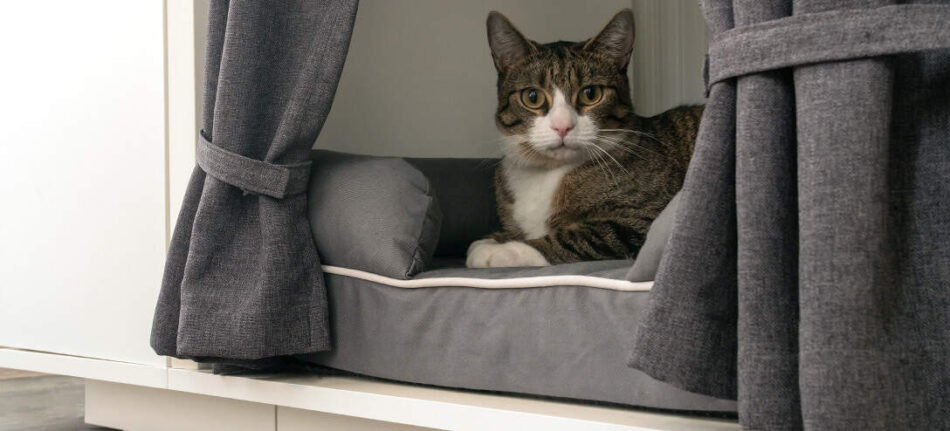
Designed to look like a piece of modern furniture, the Nook looks great in any room so can be placed in your bedroom if your cat likes to be close to you, or downstairs to give you a truly undisturbed sleep while your cat enjoys a luxurious slumber in their very own cat house.
Overall 52% of cat owners said they may prefer it if their cat slept in their own bed, yet 70% of people say they don’t regret allowing their cat to sleep on their bed. So the Maya Nook might be the purrfect compromise to keep both cats and their owners happy.
This entry was posted in Cats on May 17th, 2019 by chloewelch
Looking for a breakfast treat that will impress guests, but doesn’t take all morning? Put your girls’ eggs to delicious use with this gooey Nutella French Toast and a selection of toppings, perfect for a tasty brunch to be enjoyed with family and friends.

Ingredients – serves 4
- Sliced Brioche Loaf (8 slices serves 4)
- Lots of Nutella!
- 2 eggs
- 2 tbsp milk
- ½ teaspoon vanilla extract
- Butter for frying
- Toppings of your choice. We recommend a dusting of icing sugar, fresh berries, vanilla ice cream, and more Nutella!
Method
- In a bowl, beat together the eggs, milk and vanilla extract. Pour into a shallow dish, such as a pasta bowl.
- Spread Nutella (as much as you would like!) on one side of 2 slices of the brioche loaf and put together to create a sandwich.
- Pop roughly a teaspoon of butter in a frying pan on a medium heat.
- Soak each side of the Nutella brioche sandwich in the egg mixture for a couple of seconds, and then place in the frying pan when the butter is melted and hot.
- Allow the brioche to fry for 1-2 minutes on each side until golden brown.
- We cut these into thirds and served with a selection of toppings for guests to choose from.
This entry was posted in Recipes on May 17th, 2019 by chloewelch
Using a steam cleaner to clean any Eglu can be a very effective way. It will not affect the plastic, whereas all surfaces are cleaned, disinfected, and all killed mites, insects and dust are blown away by the power of the steam. As a bonus the surfaces will be dry in no time, because the plastic is warmed up.

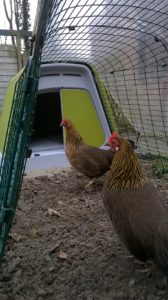
Deep-cleaning an Eglu Go once or twice a year is extra easy if one follows these steps:
1. Take of the top panel (lid)
2. Unscrew both side panels and bumpers, and take these off as well. For a complete cleaning you may want to disconnect the run as well.
3. You now have access to all inner and outer surfaces. Clean them thoroughly with the steam cleaner, if required using an old dish brush as well.
4. Clean the bumpers, panels and top lid in the same way.
5. Re-assemble the run and the coop.
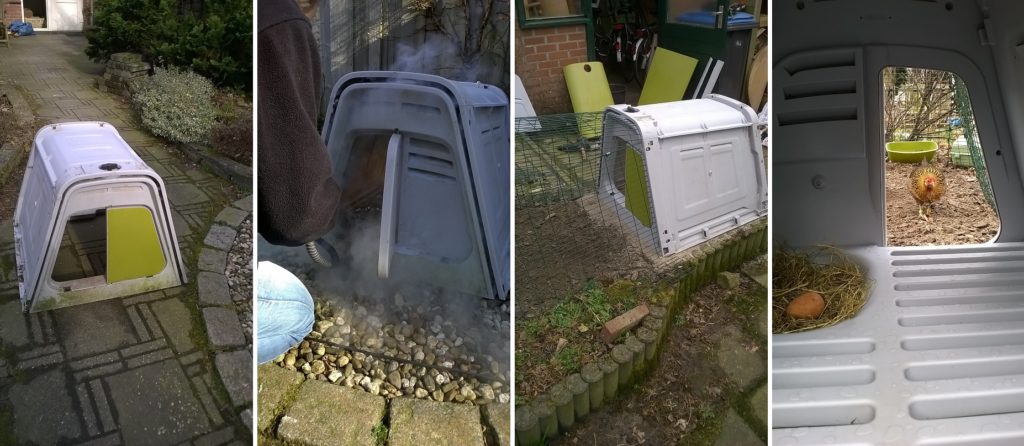
This cleaning method has been used for several years now by our Dutch team-member and is guaranteed to keep your Eglu in a top condition, without damaging any parts!
This entry was posted in Chickens on May 17th, 2019 by chloewelch
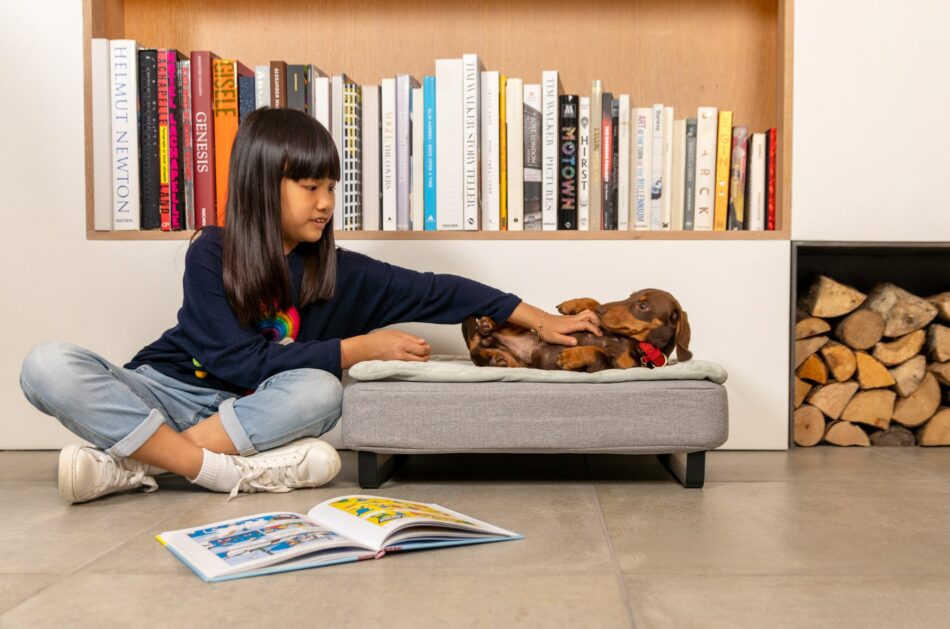
The bond between man and dog is a profound connection that dates back centuries. As every pet parent knows, our four-legged friends often communicate their affection through subtle, yet unmistakable signs. From tail wags that speak volumes to those soulful gazes that melt your heart, our canine friends possess a unique language that expresses love in ways beyond words. Understanding these signs not only strengthens your bond together, but deepens your appreciation for the companionship that dogs bring into our lives. Join us as we explore and reveal the 8 signs that your dog loves you.
1. Tail-wagging welcomes
There’s nothing quite like the exuberant, tail-wagging embrace you receive from your dog when you enter your home. Whether you were gone for 5 minutes or all day at work, their excitement to see you is heard in every joyful bark and seen in every ecstatic spin. It’s as if they’re saying, “You’re home! I miss you so much!”. This genuine delight that we see in our dogs when we arrive home is a testament to their love for us, and with such a warm welcome waiting, the bond between us and them can only deepen daily.
2. Doggy deep breaths
We know that yawning is contagious between humans, but did you know that studies show that dogs are more likely to yawn simultaneously with their owners than with someone they don’t know? It’s suggested that this is a way for dogs to show empathy, and that yawning together with their owners is a sign of affection. For dogs, yawning in the presence of their beloved humans is most often a sign of relaxation and a demonstration of their deep connection with you. But sometimes, your dog’s yawns can be indicative of stress – so make sure you can distinguish their accompanying body language. The next time your pup stretches their jaws with a relaxed body and lets out a yawn, take it as a heartwarming “I love you” in their language.
3. Love licks
Ever noticed how your dog gives you a big, slobbery smooch when you least expect it? Well, that’s no accident! For dogs, licking isn’t just about cleaning themselves or for tasting – it’s one of the strongest ways for dogs to show their pure, unadulterated love. It all goes back to puppyhood. Puppies lick their mother’s face to communicate their needs and show affection and this behavior continues into adulthood.
When your pup plants a wet kiss on your hand or face, they’re not just clearing any leftover crumbs from dinner; they’re bonding with you! So if your dog showers you with licks, just embrace it. The slobber can be wiped away but the fact that your dog thinks you’re the best thing since bacon-flavored treats is irreplaceable.
4. Puppy presents
When your dog brings you their favourite chew toy or nudges their treasured ball in your direction, it’s not just an invitation to play – it’s a declaration of love. Dogs are inherently social animals and they view their humans as part of their pack. So, naturally, sharing their beloved dog toys is a way to foster unity and create a connection. Whether it’s a squeaky plushie or a weathered rope, the act of sharing their toys is your dog’s sign that they trust and adore you. So the next time your furry friend plops their favourite toy on your lap, engage with them and show them you love them just as much.
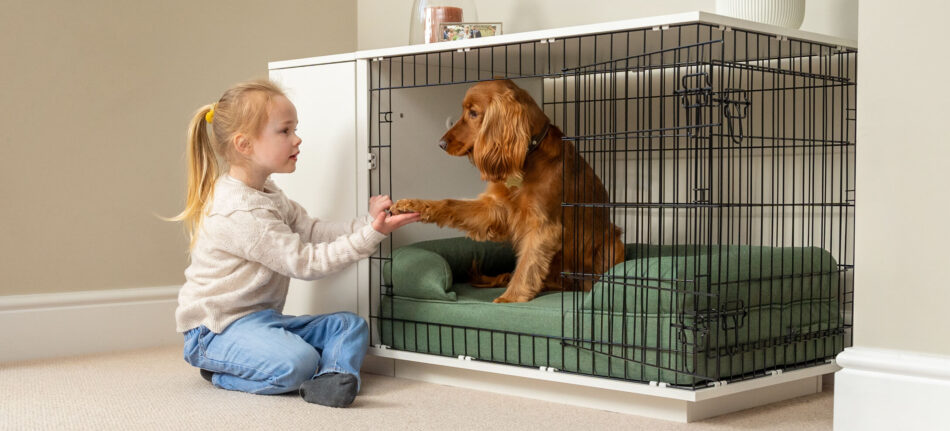
5. Scent masters
Did you know that dogs possess an extraordinary sense of smell that is 10 to 100 times more acute than that of humans? They use this superpower to not just find their toys or detect treats but also to form deep emotional connections. For dogs, everything has its own unique scent – including you. And since you’re their person, they recognize your specific smell amidst a sea of all others because of the emotional attachment they have to it.
You might get a bit annoyed when your pup steals your underwear and runs around the house with them, but try to remember that this thievery is actually a strong sign of affection. It means that your dog wants to feel close to you even when you’re not right next to them. So if you see your dog doing this, leave an old T-shirt in their bed when you’re out of the house to help make them feel safe.
6. Puppy dog eyes
When it comes to non-verbal communication, dogs are the masters. If you’ve ever caught your dog staring at you it’s likely not just a casual glance. For dogs, maintaining eye contact is their way of telling you that they love you. In fact, eye contact releases the hormone oxytocin in the brain, which triggers feelings of comfort and affection, ultimately creating a stronger bond between you and your canine companion. And what’s even more interesting is that this silent way of showing affection is usually only reserved for their people. Dogs don’t use eye contact in the same way within their own species and prolonged eye contact between two dogs can actually be a sign of aggression.
7. Love lounging
There are several ways your dog can use body language to show that they feel completely comfortable in your presence. When dogs exhibit relaxed body language, it’s a remarkable display of their deep-rooted love and affection towards you. With a loose stance, ears in a neutral position, and a slightly open mouth, your dog is signifying total comfort and ease in your relationship. Your dog can literally make its body be a reflection of affection for you, which is a testament to their unbroken trust in you.
8. Canine comfort
In the wild, dogs sleep huddled with their pack for warmth and security. But through domestication, you’re the only pack they have, so you may find your furry friend choosing to snuggle up next to you instead. When allowed to, dogs will sleep as close to their beloved humans as possible, both to feel protected and to protect the people they love the most – which is you. In a similar way, dogs also show you their love by staying close to you when they are feeling stressed or intimidated.
While we all love a good snuggle with our pets, when it’s time for them to nap or sleep for the night, it’s important to find them a dog bed that suits your canine’s comfort needs. The Omlet Topology Dog Bed is the perfect snuggle substitution with its customisable toppers that can be paired with your dog’s specific sleep style. Every snuggle is special and we designed the Topology Dog Bed to reflect that.
Omlet and your dog
From wagging tails to soulful gazes, one thing remains clear – our dogs can speak volumes through their unspoken language of love. At Omlet, we amplify these heartwarming connections through our products that bring you and your pet closer together. Identifying the signs your dog is sending to show you their love is easy. Meeting them with the same unconditional love in return is the “why” behind all of Omlet’s designs and creations like the Topology dog bed and dog crates. After all, the bond between human and canine is as old as time and one that should be celebrated.
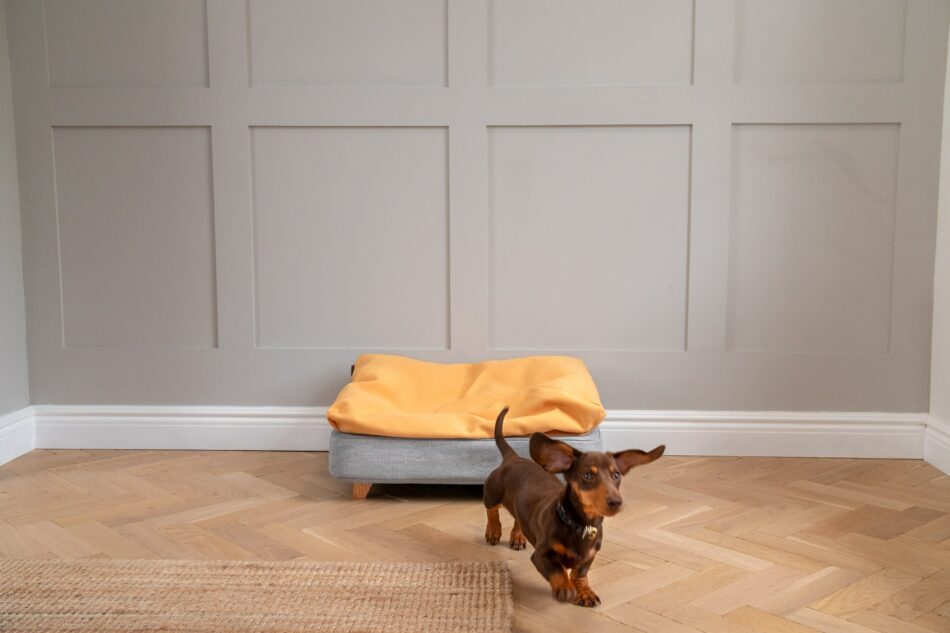
This entry was posted in Dogs on May 8th, 2019 by linnearask
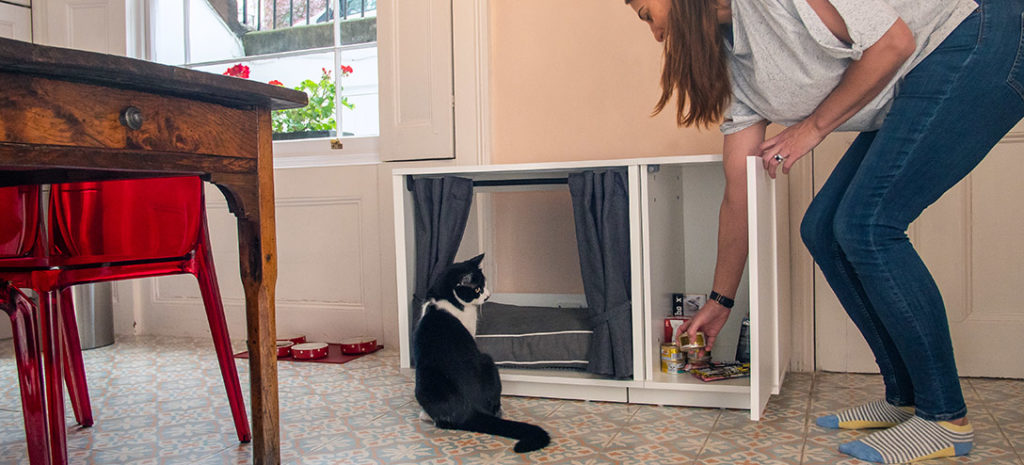
We are giving away an ameowzing starter pack worth over $90 when you order the NEW Maya Nook Luxury Indoor Cat House – the purrfect moving in present to celebrate your feline friend’s new home.
The FREE bundle will include:
- A Maya Nook Cat Bed
- A set of Curtains for your Maya Nook
- A engaging cat toy
To claim your free starter pack when you purchase a New Maya Nook Cat House, simply enter code MAYA at checkout.
We’re not kitten around – this offer is fur real and available for a limited time only!
The NEW Maya Nook Cat House is the ultimate cosy bed for your cat to relax and sleep in peace and quiet. This stylish piece of furniture looks great in your home while providing your cat with a space they can call their own. The integrated wardrobe provides a neat way to keep your cat’s toys and treats tidy and out of sight, while the NEW Maya Nook curtains allow your cat to get the undisturbed sleep they desire. Read more about the NEW Maya Nook Cat House here.
Terms and Conditions
Free Starter Pack bundle is only valid with orders of the Maya Nook Indoor Cat House from 01/05/19 – midnight 09/05/19. Use promo code MAYA at checkout to receive your FREE starter pack. The starter pack includes one pair of curtains only. Items in the free bundle are subject to change. Subject to availability. While stocks last. Omlet ltd. reserves the right to withdraw the offer at any point.
This entry was posted in Cats on May 2nd, 2019 by linnearask

















